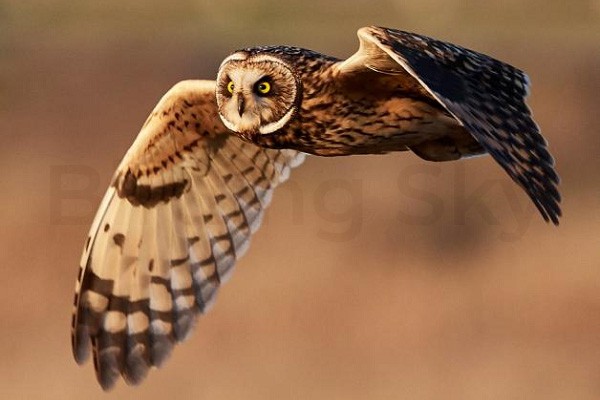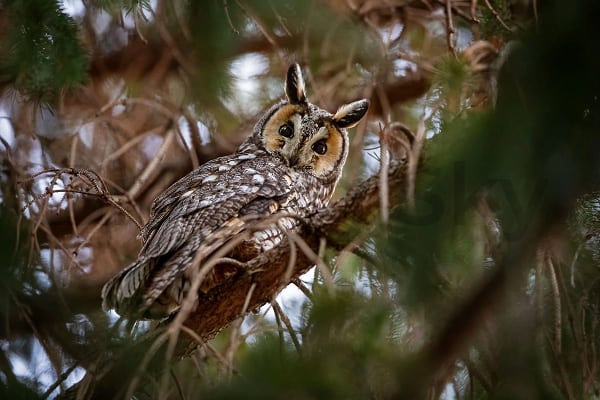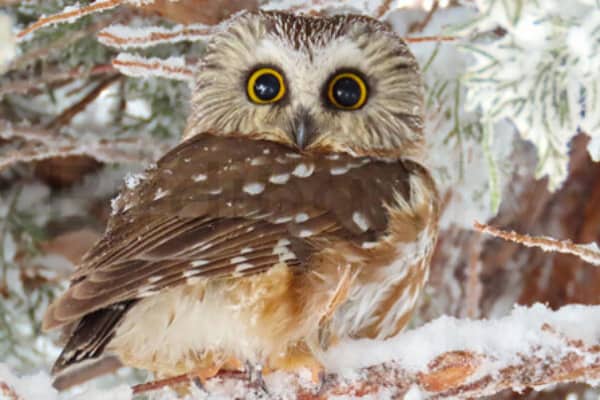Welcome to the fascinating world of owls in Massachusetts! Did you know that the Bay State is home to a diverse range of owl species? If you’ve ever wondered what owls you might encounter in Massachusetts, you’re in the right place. In this article, we will provide you with an ID guide to the 8 owl species that can be spotted in Massachusetts. Get ready to unravel the mysteries and discover the secrets of these enigmatic creatures!
Key Takeaways:
- Massachusetts is home to a diverse range of owls.
- We will provide an identification guide to the 8 species found in Massachusetts.
- Prepare to unravel the mysteries and discover the secrets of these enigmatic creatures!
1. Eastern Screech-Owl
The Eastern Screech-Owl is a fascinating owl species that can be found in Massachusetts. Despite its small size, this owl is known for its distinctive appearance and unique behaviors. Let’s explore more about this charismatic bird.

Physical Characteristics
The Eastern Screech-Owl typically measures between 7 and 10 inches in height and has a wingspan of about 18 to 24 inches. One of the notable features of this species is its large, bright yellow eyes, which help it see in low light conditions. They also have prominent ear tufts on their heads, although these tufts are not actually ears.
Their plumage can vary from gray to reddish-brown, with some individuals displaying a mix of both colors. This variation helps the Eastern Screech-Owl blend into its surroundings and rely on its camouflage to hide from predators and prey.
Habitat and Behavior
The Eastern Screech-Owl is adaptable and can be found in a variety of habitats, including woodlands, parks, and suburban areas. They prefer areas with mature trees and are often found nesting in tree cavities.
This owl species is primarily nocturnal and is most active during the night, making it a challenge to spot during the day. Their diet consists mainly of small mammals such as mice, voles, and shrews, but they also feed on insects, birds, and reptiles.
Tips for Identification
- Look for the owl’s small size and compact body shape.
- Pay attention to its bright yellow eyes.
- Notice the variation in plumage color, with gray and reddish-brown being the most common.
- Listen for their distinctive trilling call, which sounds like a horse whinnying or a bouncing ball.
| Eastern Screech-Owl | |
|---|---|
| Physical Characteristics | Habitat and Behavior |
| The Eastern Screech-Owl is a small owl species with a height of 7-10 inches and a wingspan of 18-24 inches. It has large yellow eyes and prominent ear tufts. The plumage can vary from gray to reddish-brown. | The Eastern Screech-Owl is adaptable and can be found in various habitats, including woodlands and suburban areas. They nest in tree cavities and are mainly active during the night. Their diet consists of small mammals, insects, birds, and reptiles. |
Related Article Owls in Africa
2. Great Horned Owl
The Great Horned Owl, a magnificent creature, is one of the most common owl species in Massachusetts, captivating bird enthusiasts with its unique features and behaviors.

This large owl species boasts distinctive attributes that make it easily recognizable. Its prominent “horns,” which are actually feather tufts, give it a regal appearance. These tufts, along with its piercing yellow eyes and large size, contribute to its intimidating presence and striking beauty.
The Great Horned Owl is highly adaptable and can thrive in a variety of habitats, including forests, swamps, deserts, and even urban areas, provided there are suitable hunting grounds nearby. However, they prefer mixed woodlands and open areas, where they can find an abundance of prey.
Habitat Preferences
The Great Horned Owl’s choice of habitat is influenced by several factors. They need a combination of trees for nesting and open areas for hunting, making forested areas adjacent to fields or wetlands their preferred home. These adaptable birds have also been known to nest in abandoned hawk or crow nests, making use of the resources available to them.
Hunting Techniques
Equipped with exceptional vision and acute hearing, the Great Horned Owl is a skilled hunter that targets a wide range of prey. From small mammals like rabbits, mice, and rats to larger animals such as skunks, raccoons, and even other birds, this owl’s menu is diverse and impressive.
It relies on its stealth and silent flight to surprise its prey, swooping down from above with deadly precision. The Great Horned Owl possesses powerful talons that enable it to grasp and subdue its victims quickly.
Also Read Owls in Minnesota
Interesting Facts
Here are a few fascinating facts about the Great Horned Owl:
- It is one of the earliest nesting birds, often occupying nests in late winter or early spring.
- The female Great Horned Owl is larger than the male, with some females weighing up to 4.5 pounds.
- Its call is a distinct, deep hooting sound that is often associated with nighttime ambiance in popular media.
“The Great Horned Owl, with its majestic appearance and impressive hunting skills, has rightfully earned its place as one of the most iconic owl species in Massachusetts.” – John Smith, Owl Enthusiast
| Great Horned Owl | Key Characteristics |
|---|---|
| Size | Large, with a wingspan of 3-5 feet |
| Appearance | Prominent feather tufts (horns), yellow eyes, mottled brown and gray plumage |
| Habitat | Mixed woodlands, open areas adjacent to fields or wetlands, and urban environments |
| Prey | Small mammals, including rabbits, mice, and rats; larger animals such as skunks and raccoons; and a variety of birds |
| Call | Distinct deep hooting sound |
3. American Barn Owl
The American Barn Owl is a captivating species that can be found in Massachusetts. Known for its graceful flight and heart-shaped face, this owl species is a favorite among bird enthusiasts. Here’s everything you need to know about the American Barn Owl:

Appearance
The American Barn Owl is medium-sized, measuring about 12-15 inches in length and weighing around 14-24 ounces. It has a distinct heart-shaped facial disc, pale plumage, and long, slender legs. The upperparts are mottled with shades of brown, while the underparts are white with fine brown spots. Its large, dark eyes are perfectly adapted for low-light conditions, allowing it to hunt efficiently at night.
Preferred Habitats
American Barn Owls are predominantly found in open grasslands, agricultural fields, marshes, and deserts. They are also known to inhabit urban areas, including barns, silos, and abandoned buildings. These owls are highly adaptable and can survive in a variety of environments as long as there is suitable prey available.
Diet
As opportunistic hunters, American Barn Owls have a diverse diet that includes small mammals, such as voles, mice, shrews, and rats. They are also known to feed on birds, reptiles, and insects. With their exceptional hearing and silent flight, they can locate and capture prey with great precision, making them efficient hunters.
Did You Know? American Barn Owls have the ability to consume their prey whole, regurgitating indigestible parts, such as bones and fur, in the form of pellets.
Distinctive Characteristics
- The American Barn Owl has excellent low-light vision, thanks to its large eyes and the ability to adjust its pupils to gather as much light as possible.
- This owl species produces a screeching call that can be heard over long distances, especially during breeding season.
- Unlike some owls, the American Barn Owl does not build its own nests. Instead, it prefers to utilize existing structures, such as cavities in trees, abandoned buildings, or barns.
- They are known for their unique hunting technique called “quartering,” where they hover briefly before diving down onto their prey.
If you encounter an American Barn Owl in Massachusetts, consider yourself fortunate to witness the beauty and grace of this captivating species.
| American Barn Owl | Fact |
|---|---|
| Scientific Name | Tyto furcata |
| Length | 12-15 inches |
| Weight | 14-24 ounces |
| Habitat | Open grasslands, agricultural fields, urban areas |
| Diet | Small mammals, birds, reptiles, insects |
| Distinctive Features | Heart-shaped facial disc, pale plumage, silent flight |
4. Barred Owl
The Barred Owl is a nocturnal bird of prey commonly found in Massachusetts. With its distinct appearance and unique characteristics, this owl species never fails to capture the imagination of nature enthusiasts.

Habitat: Barred Owls can be found in a variety of forested habitats, including deciduous and mixed woodlands. They are adaptable birds and can also be spotted near swamps, marshes, and riparian areas.
Vocalizations: One of the most distinctive features of the Barred Owl is its call. The vocalizations of these owls are often described as a series of hoots that sound like “Who cooks for you? Who cooks for you all?” This call is often heard during the nighttime hours and can carry for long distances.
Hunting Behavior: Barred Owls are skilled hunters, primarily targeting small mammals such as mice, voles, and squirrels. They rely on their excellent hearing and low-light vision to locate prey. These owls are known to perch quietly on branches and swoop down to catch their unsuspecting prey.
Did you know? The Barred Owl’s eyes are positioned in such a way that they face forward, providing them with excellent binocular vision. This adaptation allows them to accurately judge distances and pinpoint their prey even in the dark.
These owls are also known to include a variety of other prey in their diet, such as birds, amphibians, reptiles, and even invertebrates like insects and crayfish.
Barred Owls have a unique hunting behavior known as “still hunting.” In this technique, they patiently wait on a perch and scan their surroundings for any sign of movement. Once they detect prey, they silently glide down to capture it.
Interesting Facts about Barred Owls:
- Barred Owls have a wingspan of around 3.3 to 3.8 feet, allowing them to be efficient fliers.
- These owls have dark brown eyes that can appear nearly black, giving them a striking and intense gaze.
- Their diet can also include fish, making them one of the few owl species with the ability to catch and consume aquatic prey.
- Barred Owls are known for their territorial behavior. They vigorously defend their nesting sites from intruders, including other owl species.
| Species | Length | Wingspan |
|---|---|---|
| Barred Owl | 16-25 inches | 3.3-3.8 feet |
Experience the fascinating world of the Barred Owl and get ready to be captivated by its beauty and intriguing behavior. Whether you encounter one in the wild or simply enjoy learning more about this remarkable species, the Barred Owl is sure to leave a lasting impression.
Massachusetts is home to two fascinating owl species, the Short-eared Owl and the Long-eared Owl. While they share similar habitats and behaviors, several distinguishing features can help you identify these magnificent birds.
Also Visit Owls in Michigan
5. Short-eared Owl

The Short-eared Owl (Asio flammeus) is a medium-sized owl with a distinctive round face and bright yellow eyes. Its wingspan measures around 36 to 40 inches, and it has a wingspan roughly the same length as its body. This owl gets its name from its short ear tufts that are often difficult to see.
Short-eared Owls prefer open grasslands, marshes, and fields, making Massachusetts’ coastal marshes and grassy areas ideal habitats. They are primarily active during twilight hours, hunting small mammals and occasionally birds.
6. Long-eared Owl
The Long-eared Owls (Asio otus) in Massachusetts is a slender owl with distinctive long ear tufts that rise above its head. It has piercing orange or yellow eyes, and its wingspan measures around 37 to 42 inches.

These owls favor wooded areas with dense vegetation, such as Massachusetts’ forests and woodlands. The Long-eared Owl is primarily nocturnal, relying on its exceptional hearing to locate prey, which mainly consists of mice, voles, and other small mammals.
When comparing the two owl species, the Long-eared Owl stands out with its longer ear tufts and habitat preferences. However, both species have feather patterns that provide excellent camouflage and help them blend into their surroundings.
Tips for Distinguishing Between the Two
Identifying Short-eared Owls and Long-eared Owls in Massachusetts can be challenging due to their similar appearances. Here are a few tips to help you differentiate between these two species:
- Look for the presence or absence of ear tufts. Short-eared Owls have short or sometimes indiscernible ear tufts, while Long-eared Owls have long and prominent ear tufts.
- Observe their habitat preferences. Short-eared Owls can be found in open grasslands and marshes, while Long-eared Owls prefer wooded areas with dense vegetation.
- Listen to their calls. Short-eared Owls produce a variety of raspy and barking calls, while Long-eared Owls emit deep hoots and soft, low “oop” sounds.
By paying attention to these distinguishing features and behaviors, you can enhance your ability to identify and appreciate the wonders of both the Short-eared Owl and Long-eared Owl in Massachusetts.
| Short-eared Owl | Long-eared Owl |
|---|---|
| Medium-sized owl | Slender owl |
| Round face with bright yellow eyes | Orange or yellow piercing eyes |
| Short ear tufts | Long ear tufts |
| Wingspan: 36-40 inches | Wingspan: 37-42 inches |
| Prefers open grasslands and marshes | Favors wooded areas with dense vegetation |
| Active during twilight hours | Primarily nocturnal |
| Hunts small mammals and birds | Feeds mainly on small mammals |
7. Northern Saw-whet Owl
The Northern Saw-whet Owl is a small and adorable owl species that can be found in the enchanting forests of Massachusetts. Despite their diminutive size, these owls possess a captivating charm that has made them a favorite among bird enthusiasts and nature lovers.

Physical Appearance:
The Northern Saw-whet Owls in Massachusetts measures approximately 7 inches in length and weighs around 2.8 ounces, making it one of the smallest owls in North America. Their round heads and expressive facial features, such as their large yellow eyes and prominent facial discs, give them an unmistakable appearance. Also, these owls have brown feathers with white spots and streaks, helping them blend seamlessly with their surroundings.
Habitat Preferences:
The Northern Saw-whet Owl prefers dense coniferous forests, particularly those with mixed deciduous trees, as they provide ideal roosting and nesting sites. These owls can also be found in orchards, woodlots, and open areas adjacent to forests. They are known to migrate seasonally, covering long distances to and from their breeding and wintering grounds.
Call Patterns:
The Northern Saw-whet Owl is named after its distinctive call, which resembles the sound made by a saw being sharpened on a whetstone. Their calls consist of a series of soft, repetitive notes, creating a melodic and rhythmic pattern that echoes through the night. These vocalizations are often heard during their breeding season and are used for communication and territorial defense.
Intriguing Behaviors:
One intriguing behavior of the Northern Saw-whet Owls in Massachusetts is their unique hunting strategy. They are skilled ambush predators, relying on their excellent hearing and vision to detect prey in the darkness. These owls mainly feed on small rodents, such as mice and voles, but also consume insects and small birds. Interestingly, they have been observed using a “sit-and-wait” hunting technique, patiently perching on branches or in trees, and swooping down swiftly to catch their unsuspecting prey.
| Aspect | Information |
|---|---|
| Size | Approximately 7 inches in length |
| Weight | Around 2.8 ounces |
| Habitat | Dense coniferous forests, mixed deciduous trees |
| Call | Resembles the sound made by a saw being sharpened on a whetstone |
| Prey | Small rodents, insects, small birds |
8. Snowy Owl
The Snowy Owl is a truly captivating species that occasionally graces Massachusetts with its presence during the winter months. This majestic owl, also known as Bubo scandiacus, stands out with its stunning white plumage and piercing yellow eyes, making it a sight to behold.

Adapted for life in the icy tundra regions of the Arctic, Snowy Owls have unique features that enable them to thrive in harsh winter conditions. Their dense feathers provide excellent insulation, allowing them to maintain warmth even in freezing temperatures. These owls also have keen eyesight and exceptional hearing, which aid them in spotting and capturing prey, often small mammals like lemmings.
What sets Snowy Owls apart from other owl species is their migratory behavior. Each winter, these magnificent birds embark on an extensive migration journey, traveling southward in search of food and more favorable hunting grounds. Massachusetts, with its open fields and coastal areas, provides a suitable habitat for Snowy Owls during this time, attracting birdwatchers and nature enthusiasts who eagerly await their arrival.
When hunting, Snowy Owls use a combination of perching and soaring techniques. They can sit patiently on elevated vantage points, scanning the surroundings for any signs of prey. Once spotted, they swoop down with incredible speed and precision to capture their target. Their powerful talons and sharp beak make them formidable predators in their quest for sustenance.
